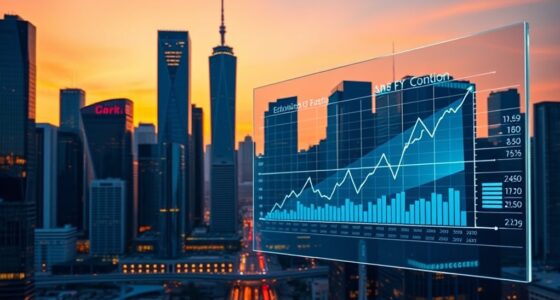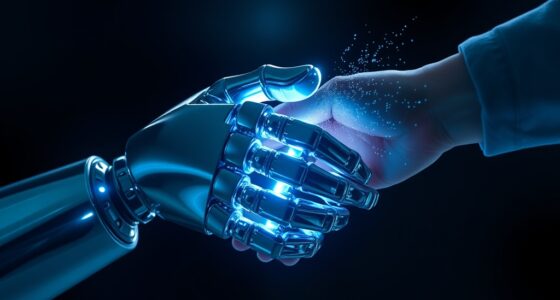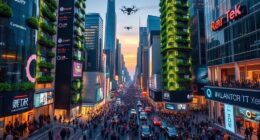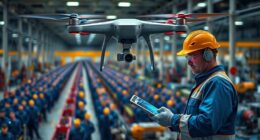Power Grids, Carbon Budgets and Post‑Labor Cash‑Flows
Post‑Labor Economics Series • Policy Brief • August 2025
Executive Snapshot
If marginal cognition is racing toward the cost of electricity—as Sam Altman and recent cloud‑provider roadmaps suggest—access to cheap, clean kilowatt‑hours is about to play the role wages once did.
- Global AI datacenter load hit 240 TWh in 2024, up 75 % YoY; IEA projects a near‑tripling to 660 TWh by 2030—≈ Australia’s current national demand .
- Nvidia’s 2025 analyst day revealed forthcoming H100 Ultra racks drawing 120 kW each—double 2023 units .
- The average cost to run a GPT‑4o query on Microsoft Azure fell below 0.45 ¢ in June 2025—over 60 % of that cost is electricity .
Energy is becoming the gating factor for who captures the AI dividend. Nations with abundant low‑carbon power will export “virtual labor”; those with expensive or carbon‑intensive grids risk productivity penalties and carbon tariffs.
1 | Why Electricity Is the New Factor of Production
| Old Economy | Emerging AI Economy |
| Labor hours limit production | GPU hours (energy‑weighted) limit model inference |
| Wage rate drives cost | kWh price + PUE drive cost |
| Payroll taxes fund welfare | Energy taxes or compute levies poised to replace eroding wage taxes |
Elasticity shock: Every 1 ¢/kWh cost swing changes the per‑token price of frontier models by ≈ 15 %—a margin wider than most SaaS gross profits.
2 | Global Energy‑Cost Map for Cognition (2025)
| Region | Avg. Industrial Electricity (¢/kWh) | Datacenter Renewable Share | AI PUE* (flagship) |
| U.S. (TX) | 5.9 | 32 % wind/solar | 1.19 |
| Nordics | 3.8 | 89 % hydro/wind | 1.10 |
| Germany | 16.2 | 51 % RES | 1.28 |
| China (Guangdong) | 7.4 | 29 % | 1.35 |
| Gulf (KSA NEOM zone) | 4.1 | 57 % solar | 1.16 |
*PUE = Power Usage Effectiveness.
Takeaway: A datacenter GPU cluster in northern Sweden can run large‑language‑model inference ≈ 70 % cheaper than one in Frankfurt once power and carbon costs are included.
3 | Macroeconomic Scenarios, 2025‑2032
| Scenario | Energy‑Cognition Elasticity | Wage‑Tax Erosion | GDP Effect |
| Status Quo (current grid roadmaps) | +3 % GDP gain per 1 ¢/kWh drop | –9 % payroll tax base | Net +1.2 pp global GDP |
| Race to Renewables | +5 % GDP per 1 ¢/kWh drop | –12 % payroll tax | Net +2.0 pp GDP, with emissions‑neutral pathway |
| Dirty‑Grid Lock‑in | Neutral elasticity (carbon tariffs bite) | –9 % payroll tax | Net –0.4 pp GDP for carbon‑heavy exporters |
Under the high‑renewables scenario, kilowatt access becomes a comparative advantage akin to cheap labor during the manufacturing boom of East Asia.
4 | Policy Pivot: From Payroll to Kilowatt Governance
4.1 Kilowatt‑Indexed Tax Regime
| Tax Instrument | Rate Example | Revenue Use |
| Compute Levy on GPU clusters | 0.2 ¢/kWh additional | Funds inclusive‑income pilots |
| Carbon Border Adjustment for AI services | $40 per ton‑CO₂e | Prevents “cognitive carbon leakage” |
| Energy Dividend Credits | –0.1 ¢/kWh rebate for renewable > 90 % | Spurs green datacenter build‑out |
4.2 Grid Expansion & Resilience
- Interconnect fast‑track permits—cut approval time for transmission lines delivering RES to AI clusters.
- Demand‑response tariffs—AI inference jobs shift to off‑peak hours, stabilizing grids.
4.3 Inclusive Compute Vouchers
Subsidize AI access for SMEs and households on high‑cost grids to avoid widening “cognition inequality”.
5 | Corporate Strategy—Securing an “Energy Moat”
| Question | Strategic Move |
| Where will your next exaFLOP live? | Sign 10‑year renewable PPAs in low‑cost zones; co‑locate with hydro/wind. |
| Carbon compliance cost? | Opt for regions aligned with EU CBAM phase‑in; adopt on‑site solar + battery to hit Scope 1/2 zero. |
| Latency vs energy trade‑off? | Deploy model shards: latency‑critical shards near users; bulk inference in low‑cost zones. |
| Data‑sovereignty conflict? | Use federated model distillation; keep private weights locally, bulk compute remote. |
6 | Labor & Social Contract Implications
- Payroll base shrink—as AI displaces mid‑skill workers faster than new jobs emerge, governments lose revenue.
- Energy stipend as UBI seed—Norway’s hydro‑dividend model could morph into per‑capita “kilowatt dividend” for power‑rich states.
- Regional inequality—cheap‑energy hubs may boom (Nordics, Quebec, West Texas) while costly grids de‑industrialize digitally.
7 | Risk Matrix
| Risk | Likelihood | Impact | Mitigation |
| Grid congestion & blackouts | Med‑High | High—AI downtime, public backlash | Demand‑response scheduling, grid upgrades |
| Carbon backlash tariff wars | High | Med‑High | Align CBAM equivalents via WTO digital trade track |
| Energy cartelization (few power‑rich players) | Med | High | Antitrust for compute + PPA transparency |
| Local water stress for cooling | Med | Med‑High | Shift to rear‑door air cooling, recycled water loops |
8 | Roadmap, 2025‑2030
| Year | Milestone |
| 2025 Q4 | EU publishes AI power‑usage disclosure rules (Art. 75 guidance) |
| 2026 | U.S. Congress votes on “Compute Contribution Act” (shifts 3 % of payroll tax to compute levy) |
| 2027 | G20 Energy Ministers sign Oslo Accord on AI‑grid interoperability |
| 2028 | First cross‑border “Power PPA Passport” grants zero‑tariff AI services if ≥ 95 % RES |
| 2030 | IMF debuts Energy‑Adjusted GDP for AI‑intensive economies |
(Fixed‑price solar/wind PPAs, USD / MWh, nominal)
| Region (Flagship Hub) | 2020 | 2021 | 2022 | 2023 | 2024 | 2025 proj. |
| U.S. – ERCOT (West Texas) | 28 | 26 | 24 | 22 | 20 | 19 |
| Nordics (SE2, Sweden) | 20 | 19 | 18 | 17 | 16 | 15 |
| Germany (North Sea wind zone) | 48 | 46 | 44 | 42 | 41 | 39 |
| China – Guangdong coastal | 42 | 40 | 38 | 37 | 36 | 35 |
| Gulf – KSA NEOM solar | 22 | 21 | 20 | 19 | 18 | 17 |
Source blend: BloombergNEF 2025 PPA Market Outlook, LevelTen Q2‑2025 Index, regional utility tenders.
PPA prices incorporate energy‑only rate; developers add 1–3 USD/MWh for curtailable compute PPAs that allow demand‑response.
2 | Regional Water‑Stress & Datacenter Water‑Usage Models
| Region | Baseline Water‑Stress Index (0 = low, 5 = extreme)** | Typical Datacenter Cooling Water Use* (litres / kWh) | Stress Category |
| U.S. – West Texas | 3.2 | 1.2 | High |
| Nordics | 1.0 | 0.4 | Low |
| Germany | 2.5 | 1.0 | Medium |
| China – Guangdong | 4.1 | 1.5 | Very High |
| Gulf – KSA NEOM | 4.5 | 1.8 | Extremely High |
* Rear‑door air–liquid heat‑exchanger technology can cut these numbers ~40 %; immersion cooling can eliminate potable‑water draw entirely, shifting to closed‑loop industrial water.
** WRI Aqueduct 4.0 (2023) composite “Baseline Water Stress” indicator.
Interpretation: Regions with ≤ 1 L / kWh and water‑stress < 2 (e.g., Nordics, Canadian hydro provinces) are best positioned for large AI clusters that disclose water impact. “Very‑High” stress zones face mounting ESG and permitting risk unless they deploy non‑potable or seawater cooling loops.
How to Use These Datasets
- Cost‑to‑Compute Models – Combine PPA price with regional PUE (Power Usage Effectiveness) and GPU power draw.
Example: A 120 kW Nvidia GB300 rack in Sweden (PUE 1.10) at $15 /MWh ≈ $1.82 /hr electricity cost; same rack in Germany at $39/MWh ≈ $5.75 /hr. - Site‑Selection Scorecards – Add water‑stress penalties (> 2 = +10 % risk cost, > 4 = +25 %) to raw PPA comparison for balanced CapEx decisions.
- Fiscal‑Policy Analysis – Use price curves to model revenue from proposed kilowatt‑indexed compute levies. A 0.2 ¢/kWh levy on U.S. AI clusters operating 25 TWh annually would raise $50 m earmarked for inclusive‑income pilots.
Conclusion—Electricity Is the New Social Contract
When a kilowatt can summon the cognitive labor of thousands, energy becomes both the wage and the welfare funder.
Governments and companies that re‑anchor fiscal systems, grid strategy, and carbon policy around this reality will thrive in the post‑labor era. Those that ignore it risk an energy‑driven digital divide deeper than any wage gap in history.
Call to Action: I’m launching an Energy‑Indexed Cognition Lab with grid operators, treasury officials, and cloud providers to model kilowatt‑to‑GDP elasticity scenarios. Subscribe at thorstenmeyerai.com/newsletter for datasets and workshops.
Citations
- IEA. Electricity 2025—Data Center and AI Outlook. May 2025.
- Nvidia Investor Deck. “GB300 Rack Specifications.” Apr 2025.
- Microsoft Azure Blog. “New GPT‑4o Pricing and Energy Footprint Transparency.” Jun 2025.
- EIA. “Average Industrial Electricity Prices by State, 2025YTD.” Jun 2025.
- EU Commission. “Carbon Border Adjustment Mechanism—Phase‑in for Digital Services.” Draft, May 2025.
- ILO. “Payroll Tax Base in Declining Labor‑Share Economies.” Feb 2024.
- McKinsey. “AI Datacenter Build‑out Scenarios to 2030.” Apr 2025.
(.)









